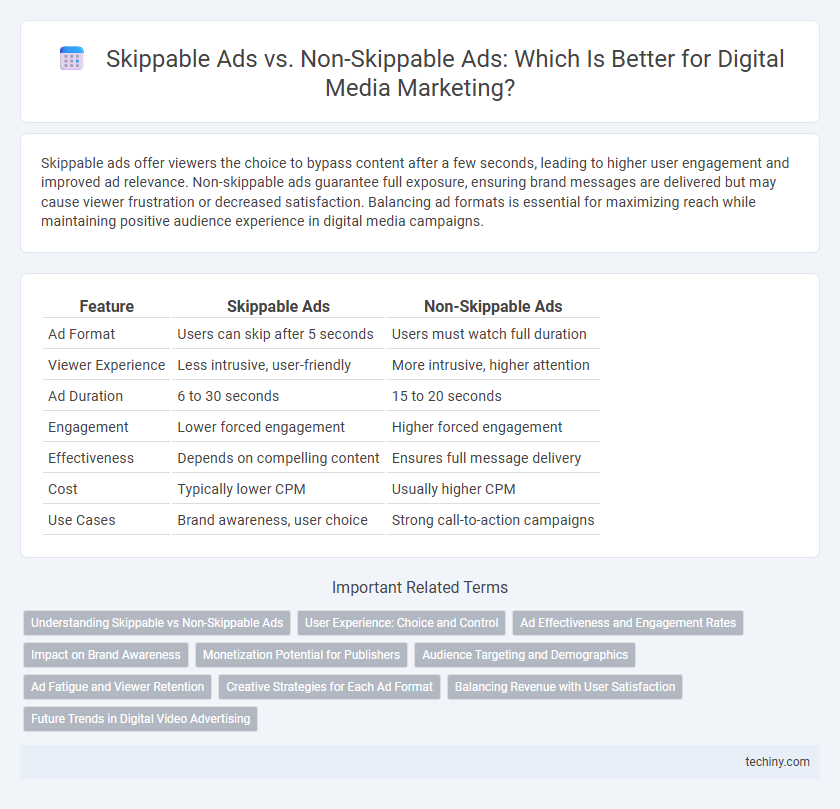Skippable ads offer viewers the choice to bypass content after a few seconds, leading to higher user engagement and improved ad relevance. Non-skippable ads guarantee full exposure, ensuring brand messages are delivered but may cause viewer frustration or decreased satisfaction. Balancing ad formats is essential for maximizing reach while maintaining positive audience experience in digital media campaigns.
Table of Comparison
| Feature | Skippable Ads | Non-Skippable Ads |
|---|---|---|
| Ad Format | Users can skip after 5 seconds | Users must watch full duration |
| Viewer Experience | Less intrusive, user-friendly | More intrusive, higher attention |
| Ad Duration | 6 to 30 seconds | 15 to 20 seconds |
| Engagement | Lower forced engagement | Higher forced engagement |
| Effectiveness | Depends on compelling content | Ensures full message delivery |
| Cost | Typically lower CPM | Usually higher CPM |
| Use Cases | Brand awareness, user choice | Strong call-to-action campaigns |
Understanding Skippable vs Non-Skippable Ads
Skippable ads allow viewers to bypass the advertisement after a short duration, enhancing user experience by reducing forced interruptions, whereas non-skippable ads require full viewing, ensuring complete advertiser message delivery. Advertisers balance engagement metrics and brand recall by selecting skippable ads for viewer retention and non-skippable ads for guaranteed exposure. Platforms like YouTube optimize ad revenue and viewer satisfaction by integrating both ad formats based on content type and audience behavior analysis.
User Experience: Choice and Control
Skippable ads enhance user experience by offering viewers the choice to bypass content, reducing frustration and increasing engagement. Non-skippable ads demand full attention, often leading to viewer annoyance but ensuring complete message delivery. Providing users with control through skippable formats fosters a positive interaction, balancing advertiser goals and audience satisfaction.
Ad Effectiveness and Engagement Rates
Skippable ads often yield higher engagement rates by allowing viewers to choose whether to watch, resulting in more qualified impressions and better ad effectiveness. Non-skippable ads guarantee full message exposure but may lead to viewer frustration and lower engagement due to forced viewing. Balancing these formats involves optimizing ad length and content relevance to maximize user retention and campaign ROI.
Impact on Brand Awareness
Skippable ads enhance brand awareness by offering viewers control, resulting in higher engagement rates and positive brand associations. Non-skippable ads guarantee full exposure, increasing message retention but often risking viewer frustration and ad avoidance. Optimizing ad strategy depends on balancing viewer experience with brand visibility to maximize impact in digital media campaigns.
Monetization Potential for Publishers
Skippable ads offer higher engagement rates by allowing users to choose whether to watch, leading to better user experience and increased ad impressions, which can enhance monetization potential for publishers. Non-skippable ads guarantee full ad views, ensuring maximum advertiser exposure and higher CPMs, making them valuable for revenue generation despite potential viewer frustration. Balancing both ad formats allows publishers to optimize their ad inventory and maximize overall earnings in digital media environments.
Audience Targeting and Demographics
Skippable ads offer advertisers precise audience targeting by allowing them to engage viewers who choose to watch the content, typically attracting younger demographics such as millennials and Gen Z who prefer control over their viewing experience. Non-skippable ads guarantee full ad exposure, making them effective for reaching broader or less engaged demographics, often favored in campaigns targeting older audiences or those less likely to skip content. Both ad formats utilize demographic data and behavioral insights to optimize ad delivery, ensuring messages resonate with specific segments and improve overall campaign effectiveness in digital media.
Ad Fatigue and Viewer Retention
Skippable ads reduce ad fatigue by allowing viewers to control their ad experience, resulting in higher viewer retention rates. Non-skippable ads often lead to increased ad fatigue due to forced viewing, which can cause viewers to disengage or abandon the content. Balancing ad frequency and relevance in both formats is essential to maintain audience engagement and minimize negative impacts on viewer retention.
Creative Strategies for Each Ad Format
Skippable ads demand concise storytelling and immediate engagement to capture viewer attention within the first 5 seconds, often utilizing strong visuals and a clear call-to-action to encourage viewers to continue watching. Non-skippable ads rely on compelling narratives and emotional resonance that maintain audience interest throughout the entire duration, typically 15 to 30 seconds, optimizing brand recall and message retention. Crafting tailored content that respects each format's viewing behavior enhances overall campaign effectiveness and maximizes return on investment.
Balancing Revenue with User Satisfaction
Skippable ads offer users control over their viewing experience, increasing engagement rates and reducing frustration, which can lead to higher long-term retention and brand affinity. Non-skippable ads guarantee full visibility for advertisers, driving immediate revenue increases but risk alienating viewers, potentially decreasing session length. Effective digital media strategies balance these formats by leveraging viewer data and AI-driven personalization to optimize ad delivery, maximizing both ad revenue and user satisfaction.
Future Trends in Digital Video Advertising
Skippable ads are expected to dominate future digital video advertising due to rising consumer demand for control and engagement metrics that favor user-driven interactions. Non-skippable ads remain relevant for brand awareness campaigns, with innovations focusing on shorter durations and interactive elements to reduce viewer irritation. Advances in AI and machine learning will optimize ad targeting, balancing advertiser goals with viewer experience to enhance overall campaign effectiveness.
Skippable Ads vs Non-Skippable Ads Infographic

 techiny.com
techiny.com